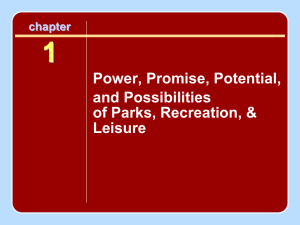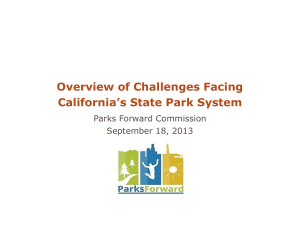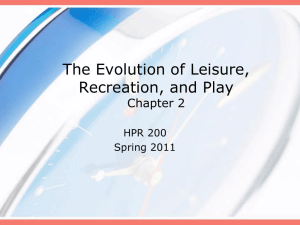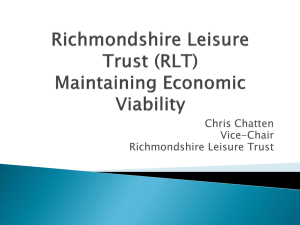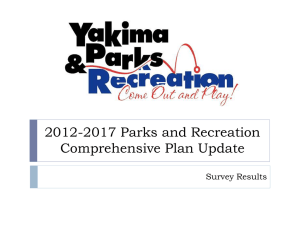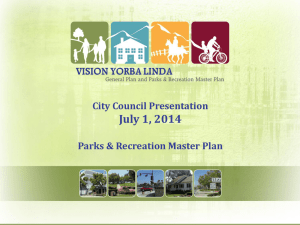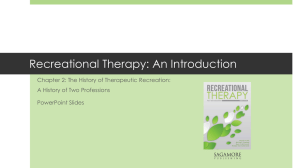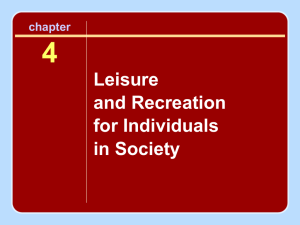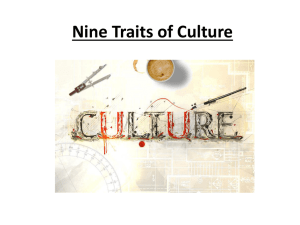chapter ??
advertisement
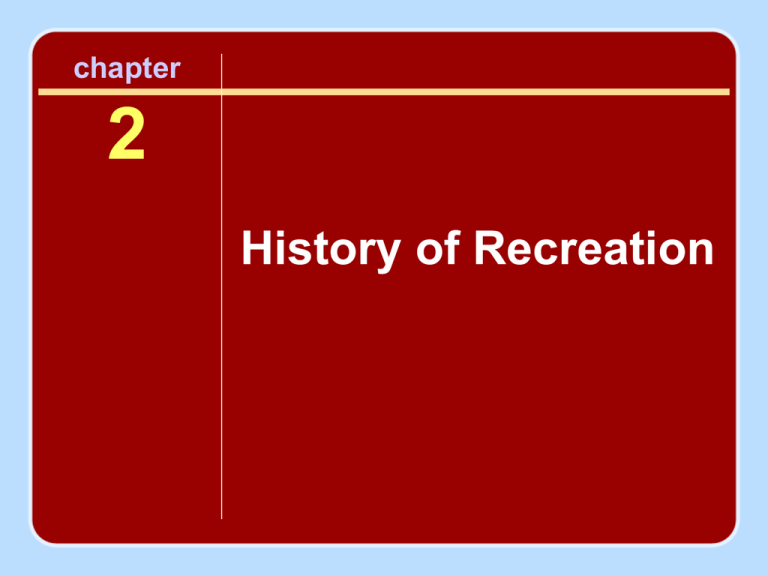
chapter 2 History of Recreation Tracing the Roots of Leisure in the United States & Canada Development of leisure was influenced by the following: • • • • Historical events of the time Societal expectations of the time Generations of immigrants From prehistoric societies to European influences and early settlement to the present day By understanding how leisure has emerged over time, it is possible to see how history often repeats itself, and what we see today is often very similar to what was experienced long ago. How Play Emerged in Prehistoric Society Play was used to do the following: • Depict historical events, transportation practices, war games, and the use of farm tools • Prepare children for their responsibilities as youth and adults • Achieve solidarity and morality • Serve as a healing experience, to relax and recover • Serve as a means of communication, pleasure, and entertainment, and serve as a means of replenishing strength after working (Kraus, 1971) Ancient Greece • Athenian ideal: – Combination of soldier, athlete, artist, statesman, and philosopher; development of all areas was valued – Made possible because tasks of everyday living were provided by laborers or slaves (Shivers & de Lisle, 1997). • Plato and his student Aristotle: – Leisure was route to happiness and the good life. – Contemplation and the pursuit of truth and understanding were thought to be the highest forms of leisure (Dare, Welton & Coe, 1987). Athenian Philosophers Believed . . . • Play was essential to the healthy growth of children from both a physical and social perspective (Ibrahim, 1979). • Leisure was opportunity for intellectual cultivation, music, theater, poetry, and political and philosophical discussions. • Schole: to cease and have quiet or peace. Time for oneself. Being occupied in something for its own sake (Ibrahim, 1991). • Schole: to embrace the experience and not the outcome. Ancient Greek Athletic Games • Males celebrated religious rites and heroes for entertainment and for pleasure. – Included chariot races, combat events, boxing, wrestling, foot races, and the pentathlon. – Competed individually, not in teams, and represented their home villages (Ibrahim, 1991). – Were encouraged to fight to the death, which was seen as noble and would immortalize the competitor for generations. • Women were excluded from public life (Shivers & deLisle, 1997). Ancient Rome Five distinct classifications of citizens included the following: • Senators were the richest, owning most of the land and power. • Curiales owned 25 or more acres of land and were office holders or tax collectors. • Plebes, or free common men, owned small properties or were tradesmen or artisans. • Coloni were lower-class tenants on land. • Slaves were indentured people exploited by their owners. (Shivers & deLisle, 1997) Opportunity for Leisure in the Roman Era Limited to people who had the appropriate resources. • The greater your standing, the greater your opportunity to free yourself from the daily requirements. • For example, senators enjoyed almost unlimited leisure, while coloni struggled to make a comfortable life. This is similar to the present day where distinct economic classes enjoy various degrees and types of leisure. Differences Between the Play of Greeks and Romans • The Greeks saw leisure as an opportunity for well-rounded development. • The Romans perceived leisure to be primarily rest from work. The Romans were on an almost constant crusade to dominate foreign cultures; play then served utilitarian rather than aesthetic or spiritual purposes (Horna, 1994). Play and the Growth of the Roman Empire • Leisure was increasingly used as a social control agent for the masses. • The increasing availability of slaves meant that labor was less required of Romans. • Daily work decreased and leisure time increased (Horna, 1994). Rome by 354 A.D. had more than 200 public holidays and 175 game days to pacify unrest by providing pleasurable experiences through celebrations (Horna, 1994). Middle Ages As the Roman Empire collapsed, the Catholic Church became the dominant structure (Shivers & deLisle, 1997). • Rejected the activities of the Roman Empire (Horna, 1994). • Believed “idleness was the great enemy of the soul.” • Clergy provided values of what was accepted in society to save a person’s soul, the highest goal at the time. • Catholic Church influenced what were acceptable and unacceptable leisure opportunities. Renaissance • Power shift from the church to the nobility included the following: – Play was perceived to be an important part of education. Rabelais (1490-1553) emphasized the need for physical exercise and games. – Montaigne (1533-1592) supported the concept of unity of mind, body, and spirit opposing the medieval ideal of separation or dualism of the mind and body. – Locke (1632-1704) believed recreation was not being idle; it helped people wearied by their work to recover. – Rousseau (1712-1778) advocated for the full freedom of physical activity rather than constraint. • Play, both as a form of popular entertainment and as a medium of education, developed. Protestant Reformation • Martin Luther and others questioned the practices of the church and split off into other Protestant religions. • Each religious group governed the perception of what was acceptable as leisure. • Play was often frowned upon as evil by certain churches during this transition. This effected the earliest development of leisure in Canada and the United States. Development of Recreation in the United States and Canada • During the 19th century, governments in both countries played a role in the provision of recreation and leisure services. • Never static, recreation and leisure evolved through wars, the Depression, longer and shorter work weeks, and other periods in the United States. In Canada the post–World War II era brought renewed interest in recreation services. Early Settlement of America • Leisure in Jamestown, Virginia, 17th century: – Community composed of aristocracy, adventurers, and traders. Exploration served the purposes of trade and profit (Shivers & DeLisle, 1997). – Colonists loved sports, games, theater, books, music, and exercise and continued to pursue these activities. – Governors banned recreational activities because of the harsh conditions the colonists faced and the need for diligence to ensure survival (Shivers & deLisle, 1997). (continued) Early Settlement of America (continued) • Leisure in New England: – Settlers were Calvinists, escaping persecution in Europe. – All forms of recreation were illegal. Settlers valued frugality, hard work, self-discipline, and observance of civil and religious codes. – Leisure was considered a sin and the devil’s work and a threat to godliness. Puritans should avoid pleasures in their own lives and struggle against pleasure in the community (Cross, 1990). – Recreation was tolerated if it could help with work. Restrictions on activities during Sundays continue today through “blue laws,” which limit the items that may be purchased (Cross, 1990). American Revolution Western expansion brought new leisure pursuits. Settlers were no longer solely European, but increasingly born in America. • Physical survival was needed in the West; shooting and wrestling matches, jumping contests, footraces, tomahawk hurling, and rail flinging were popular (Ibrahim, 1991). • Free time for frontier families had to be useful, and laboring activities were turned into recreation (Shivers and deLisle, 1997). Early Park Development in the United States • Early colonialists realized that open space was important to growing communities. – In Boston and Halifax areas known as “commons” were set aside for communal activity and meeting space. – The Boston Common, established in 1634, is viewed as the first municipal park in the United States (Kraus, 2001). • Frederick Law Olmsted designed Central Park in New York and municipal parks in Brooklyn, Philadelphia, Detroit, and Chicago. – Adapted the English style of a natural park to the rectangular restrictions of American parks (Ibrahim, 1991). – Established the basis for city parks throughout the United States. Playground Movement in the United States • The playground movement was first adopted by New York City when land was allocated for Central Park in 1855 (Ibrahim, 1991). In Chicago, Washington Park opened in 1876. • The concept of a “sand garden,” promoted by Dr. Maria Zakrzewska in Boston in 1868, was the first organized playground program. • In 1906, the Playground Association of America, formed by a small group of dedicated citizens, selected Luther Halsey Gulick, a physician, as the organization’s first president. Discussion: Subject: “The Playground Movement” The playground movement in both the United States and Canada was an important factor in bringing recreation to the masses of these growing countries. • What are the lessons from the country you are reviewing? • What could be integrated into modern society from the lessons of the era? • What programs should be developed? • Who could benefit most from a “play ethic”? Government Involvement: United States • Because decreased working time during the Great Depression meant more time available for leisure activities, the government did the following: – Developed organizations to protect natural resources and preserve them for future generations – Tackled societal problems of the day via concern for the leisure-related issues facing their citizens • President James Garfield said, “We may divide the whole struggle of the human race into two chapters: first, the fight to get leisure; and then the second fight of civilization—what shall we do with our recreation when we get it” (Kraus, 1990a, p.154). Emergence of Professional Organizations in the United States • 1906, Jane Addams, Joseph Lee, and Luther Gulick organized the Playground Association of America. • Today, the National Recreation and Park Association (NRPA) and the American Alliance for Health, Physical Education, Recreation and Dance (AAHPERD) have emerged as leaders. Post–World War II Growth: United States • Renewed desire to live life: – Suburbs and affordable housing – Mobile society through reasonably priced automobiles; increased vacation opportunities • Birth of therapeutic recreation as a distinct discipline • President’s Council on Youth Fitness created by President Eisenhower • Impact of national affluence: – Recreation services adopted marketing model. – Conspicuous consumption emerged. – Private club memberships grew, second homes were purchased, and increasingly expensive pieces of recreation equipment were within reach. Early Settlers in Canada • First Europeans, the Norse, explored west Atlantic Coast in approximately 1,000 A.D. Settled in Newfoundland (Francis et al., 1988). • In 1497, John Cabot’s expedition, fur trade with the natives. – Because a great deal of hard labor and preparation for winter was required, recreation opportunities were limited for the early settlers (Harrington, 1996). Colonization in Canada • Between 1604 and 1607, the first Acadian settlement (French speaking) was formed when Samuel de Champlain explored the coastline of the Maritimes and wintered in Port Royal. This was the first agricultural settlement in Canada (Daigle, 1982). • Champlain founded the Order of Good Cheer, which was the first social club in Canada (Francis et al., 1988). Park Development in Canada The first park in Canada, the Halifax Common, was established in 1763. • Designated for exercise for the militia in the early years. • Largely used for walking, sitting, driving, bird watching, and enjoying the plant life (McFarland, 1970). • Later, used for skating, lawn tennis, croquet, and archery (Wright, 1983). Playground Movement in Canada • Concern for those who lived in overcrowded areas with high crime rates and disease le d to the playground movement (McFarland, 1970). • Play was the only appropriate method of physical development for children and was necessary for their health, strength, and moral character (Searle & Brayley, 1993). • In 1893, the National Council of Women played a major role in initiating the playground movement (McFarland, 1970). • Playgrounds could be used to teach health and social customs in a play environment (McFarland, 1970). Government Involvement: Canada • Land for parks in Canada were deeded or leased to municipalities from the federal or provincial governments. • In 1883, Ontario passed the Public Parks Act to establish parks in cities and towns with the consent or petition of the electors. • In the 1940s, the National Physical Fitness Act influenced municipal recreation. • Interprovincial Sport and Recreation Council developed the National Recreation Statement in 1987. • Parks Canada, a federal agency, provides recreation opportunities for Canadians. Its mandate is to protect and present examples of Canada’s natural and cultural heritage and to foster understanding, appreciation, and enjoyment to ensure this heritage. Emergence of Professional Organizations in Canada • Parks and Recreation Association of Canada was formed in 1945. – After World War II, government was called to provide parks, playgrounds, and recreation services. – In 1970 name changed to Canadian Parks and Recreation Association. It’s mission is to do the following: • Build healthy communities and enhance quality of life and environment. • Communicate and promote the values and benefits of parks and recreation. • Respond to diverse changing social, economic, and political needs within the country. Provide educational opportunities. • Providing a second voice, Canadian Association for Health, Physical Education, Recreation and Dance was formed. Post–World War II Growth: Canada • The 1960s were characterized by renewed concern for physical fitness with passage of the Fitness and Amateur Sport Act (Searle & Brayley, 1993). • In 1971, Prime Minister Pierre Trudeau created ParticipACTION, a nonprofit organization to promote a healthy, physically active lifestyle to battle rising health care costs (Canadian Public Health Association, 2004). Leisure and Recreation: Similarities Between Both Countries • All three levels of government in both countries have played important roles in providing recreation services by providing funding and offering direct recreation service. • Leisure and recreation are seen as critical components of a healthy society and are a concern for both governments. This mirrors a trend that started long before in Ancient Rome. Once again, we see history repeating itself. Summary Leisure is affected by past perceptions of the following: • • • • • • • • • • • • Prehistoric societies Ancient Greeks Ancient Romans Catholic Church Protestant Reformation Renaissance Exploration and settlement of both Canada and the United States Playground movement in both the United States and Canada All levels of government in both countries Growth of professional organizations Post–World War II challenges and changes Leisure needs of women or under-represented groups
